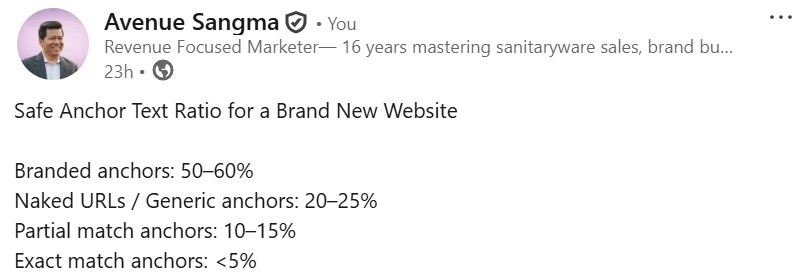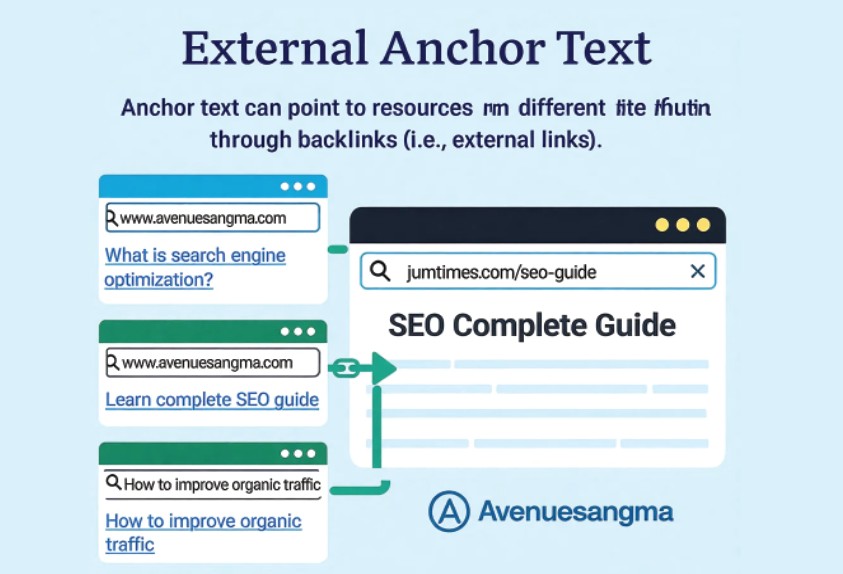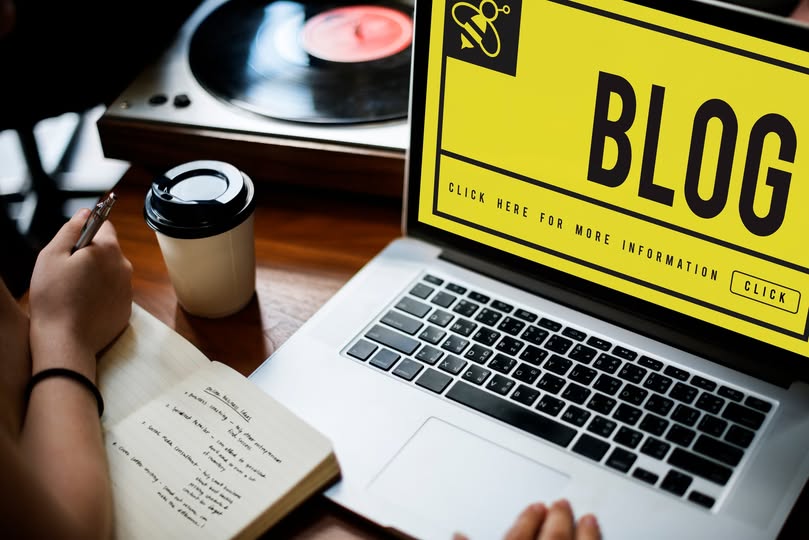When it comes to ranking higher on Google, even the smallest on-page details can make a big impact — and anchor text is one of them. Often underestimated, anchor text plays a crucial role in how search engines understand and rank your content. It serves as the clickable phrase in a hyperlink that connects one page to another, guiding both users and crawlers through your website. For instance, using an anchor like “Learn Complete Search Engine Optimization” helps visitors discover related topics while signaling to Google that the linked page provides valuable SEO insights. This makes your content more structured, relevant, and interconnected — a key step toward better search visibility.
In SEO, anchor text acts like a signal flare, telling Google what the linked page is about. When used effectively, it improves your site’s link relevance, navigation, and authority flow. But when overused or misused, it can do the opposite — causing penalties or loss of trust.
Let’s explore what anchor text really means, why it’s important, how to use it correctly, and real examples you can apply to strengthen your SEO strategy.
What Is Anchor Text?
Anchor text is the visible, clickable text in a hyperlink. It tells users what to expect when they click and provides search engines with contextual clues about the linked content.
Here’s a simple example in HTML:
<a href="https://www.avenuesangma.com/what-is-search-engine-optimization">SEO Complete Guide</a>
Here, “SEO Complete Guide” is the anchor text.

In this example:
- The anchor text is “SEO Complete Guide”.
- The href attribute defines where the link leads.
When users click the link, they visit that page.
Anchor text serves two core purposes:
- For users: It enhances readability and encourages clicks by describing the destination.
- For search engines: It signals what the linked page is about, helping them index and rank pages more accurately.
Why Is Anchor Text Important in SEO?
Anchor text is important in SEO because it helps search engines and users understand the context of linked pages. When used strategically, it signals what the destination page is about, improving relevance and keyword association in search results. Proper anchor text also enhances internal linking, guiding both visitors and crawlers through your website structure. It distributes link equity, strengthens topical authority, and boosts visibility for target keywords. However, overusing exact-match anchors or using irrelevant links can trigger search penalties. Balanced, descriptive, and natural anchor text improves user experience and builds trust — making it a key element for effective on-page and off-page SEO optimization.

1. Context for Search Engines
Search engines analyze anchor text to understand the topic of the linked page. If multiple reputable sites link to a page using “best digital marketing strategies,” Google infers that the page is likely about that subject.
2. Enhances User Experience
Descriptive anchor text helps readers know where they’re headed before clicking. Instead of vague “click here,” contextual text like “learn more about SEO best practices” adds clarity and builds trust.
3. Improves Internal Linking
Anchor text strengthens your internal linking structure by connecting related pages naturally. When used strategically, it distributes link equity (PageRank) across important pages and improves crawlability.
4. Builds Link Relevance
Both internal and external links with relevant anchor text enhance topical authority. For example, linking from a content marketing blog to a “keyword research guide” page tells Google that both topics are connected.
5. Avoids Over-Optimization
Over-optimization happens when marketers use the same keyword-rich anchor text repeatedly, making their link profile appear unnatural to search engines. Instead of improving SEO, this tactic can harm rankings and even trigger Google penalties. The key is to keep anchor text natural, relevant, and diverse.
Search engines now value variety — using a mix of exact-match, partial-match, branded, and generic anchors creates a more organic linking pattern. Each link should fit contextually within your content and sound natural to the reader.
Example of Over-Optimization:
❌ “Best anchor text SEO tips” repeated in every paragraph.
Correct Approach:
✅ Use variations like “anchor text optimization guide,” “how to improve your SEO links,” or “learn effective linking strategies.”
Benefits of Using Anchor Texts
- Improves Search Engine Understanding
Anchor text helps search engines identify what the linked page is about, boosting the chances of ranking for relevant keywords. - Enhances User Experience
Descriptive anchor text guides readers smoothly to related topics, improving navigation and engagement. - Boosts Page Authority
Well-structured internal links with proper anchor text distribute link equity, strengthening your website’s overall SEO performance. - Increases Click-Through Rates (CTR)
Clear, relevant anchor text encourages users to click and explore more pages, increasing time spent on your site. - Builds Content Relevance
Using contextual anchors connects related topics, helping Google understand your site’s thematic structure. - Supports Natural Backlink Profiles
Diverse and meaningful anchor texts make backlinks appear organic, reducing spam risks and improving ranking stability.
Types of Anchor Text with Examples
Understanding different types of anchor text helps you diversify your link profile and keep it natural.
| Type | Description | Example | Best Use Advice |
|---|---|---|---|
| Exact-Match | The anchor includes the exact keyword you’re targeting. | <a href="#">Anchor text</a> | Use sparingly; excessive use may appear spammy. |
| Partial-Match | Contains variations of the keyword phrase. | <a href="#">Effective anchor text strategy</a> | Safer and more natural for SEO. |
| Branded | Uses your brand or company name. | <a href="#">Avenue Sangma</a> | Great for building brand authority. |
| Branded + Keyword | Combines brand with target keyword. | <a href="#">Avenue Sangma SEO guide</a> | Balances branding and SEO relevance. |
| Generic | Uses general terms like “click here” or “read more.” | <a href="#">Read more</a> | Limited SEO value; use occasionally for natural flow. |
| Naked URL | Displays the full link as text. | <a href="https://avenuesangma.com">https://avenuesangma.com</a> | Neutral and safe; best for references. |
| Image (Alt-Text) | Uses an image as a link; alt text becomes the anchor. | <a href="#"><img src="seo.png" alt="SEO infographic"></a> | Always use descriptive alt text for accessibility and SEO. |
Advanced Anchor Text Types
- Semantic or Related Anchors: Use synonyms or semantically similar words instead of exact matches.
Example: “link relevance” instead of “anchor text.” - Co-Occurrence: The surrounding text around the link also gives Google additional context.
Having a diverse mix of these types creates a natural, healthy link profile.
Best Practices for Anchor Text Optimization
Here’s how to use anchor text strategically and naturally for long-term SEO growth:
1. Keep It Descriptive and Relevant
Anchor text should clearly describe the linked content. Avoid vague phrases like “click here.” Instead, use text that informs the reader what they’ll find.
2. Avoid Keyword Stuffing
Using the exact same keyword repeatedly looks spammy. Mix exact, partial, and branded anchors to maintain authenticity.
3. Match Intent with Target Page
The anchor should align with the topic of the linked page. Misleading anchors harm user trust and ranking signals.
4. Use Crawlable and Proper HTML Tags
Ensure links are formatted with correct <a> tags and accessible to search engines. Avoid JavaScript-based or hidden links.
5. Optimize Image Alt Text
For image-based links, write descriptive alt text that reflects the target page’s content — this acts as the anchor for crawlers.
6. Diversify Your Anchor Profile
Use a mix of:
- 50–60% branded anchors
- 20–25% partial-match anchors
- 10-15% generic/naked URLs
- <5% exact-match anchors

This creates a balanced and natural pattern.
7. Link Naturally Within Context
Integrate anchors smoothly into your sentences. They should enhance readability, not interrupt it.
8. Audit Your Anchors Regularly
Use SEO tools like Ahrefs, SEMrush, or Moz to monitor your anchor distribution. Remove or update spammy or over-optimized anchors.
Common Anchor Text Mistakes to Avoid
Even experienced SEOs can fall into anchor text traps. Avoid these common errors:
- Over-Optimized Anchors: Using too many exact-match keywords.
- Irrelevant Links: Anchors that don’t match the destination topic.
- Hidden or Cloaked Links: Violates Google’s Webmaster Guidelines.
- Excessive Generic Anchors: Overuse of “click here” or “learn more.”
- Duplicate Anchors: Linking multiple pages with the same anchor text confuses search engines.
- Broken or Non-Crawlable Links: If Google can’t follow them, they’re useless.
By steering clear of these mistakes, your anchor text strategy remains compliant and effective.
Anchor Text Examples (Correct vs. Incorrect)
Let’s look at practical examples:
✅ Correct Use
- Internal link: “Explore our complete guide on Technical SEO checklist.”
- Branded: “Learn more about innovative strategies at Avenue Sangma.”
- Partial-match: “Our article covers effective anchor text optimization tips.”
- Image link:
<img src="seo-guide.jpg" alt="SEO Guide for Beginners">
❌ Incorrect Use
- Over-optimized: “Best anchor text SEO, anchor text SEO tips, anchor text SEO examples.”
- Misleading: “Click here” linking to an unrelated product page.
- Hidden: White text links on white background.
The difference lies in relevance, clarity, and balance.
Anchor Text Optimization Strategy (Step-by-Step)
Use this actionable checklist to optimize your anchor text systematically:
- Keyword Mapping: Assign specific target keywords to each page.
- Plan Internal Links: Identify pages that deserve link authority.
- Vary Anchor Texts: Mix branded, exact, and semantic variations.
- Use Contextual Placement: Insert links where they add real value.
- Track Usage: Monitor how often a keyword appears as an anchor.
- Audit Backlinks: Check external links for unnatural anchors.
- Update Old Content: Replace outdated or generic anchors.
- Measure Impact: Track ranking improvements and crawl behavior in Google Search Console.
Following this framework ensures a clean, natural, and effective linking structure.
External Anchor Text Impact on SEO
Anchor text may be a small element in your content, but its impact on SEO is immense. It tells search engines what your pages mean, guides users seamlessly, and connects your site structure like an intelligent roadmap.

When used strategically — with variety, relevance, and balance — anchor text in SEO enhances both rankings and user experience. Remember: natural linking always outperforms forced optimization.
Keep your anchors honest, contextual, and useful — and you’ll build stronger SEO foundations that Google (and your readers) will trust for years to come.
Key Takeaways
- Anchor text is the clickable, visible text in a hyperlink.
- It guides both users and search engines toward contextual understanding.
- Use a mix of exact, partial, branded, and generic anchors.
- Avoid keyword stuffing or unnatural patterns.
- Keep links relevant, descriptive, and crawlable.
- Audit anchor distribution regularly for healthy link profiles.
Used wisely, anchor text is not just a hyperlink — it’s an SEO signal that builds trust, authority, and user satisfaction.


